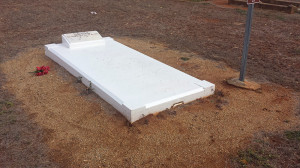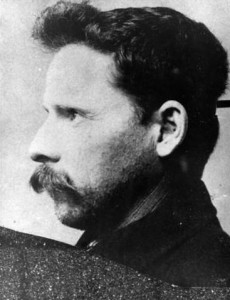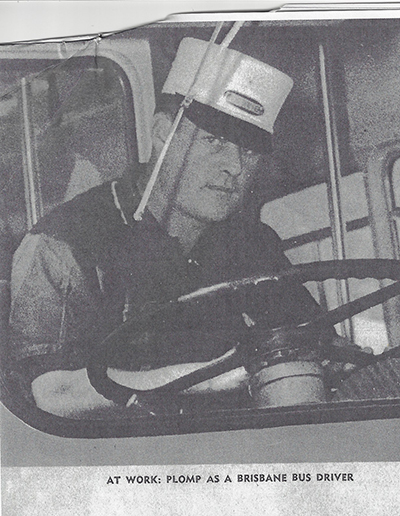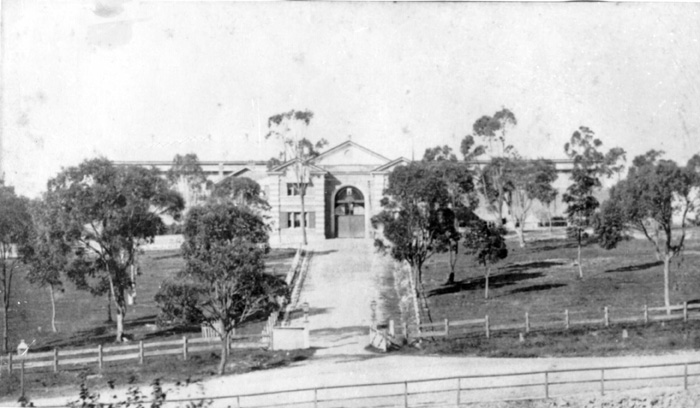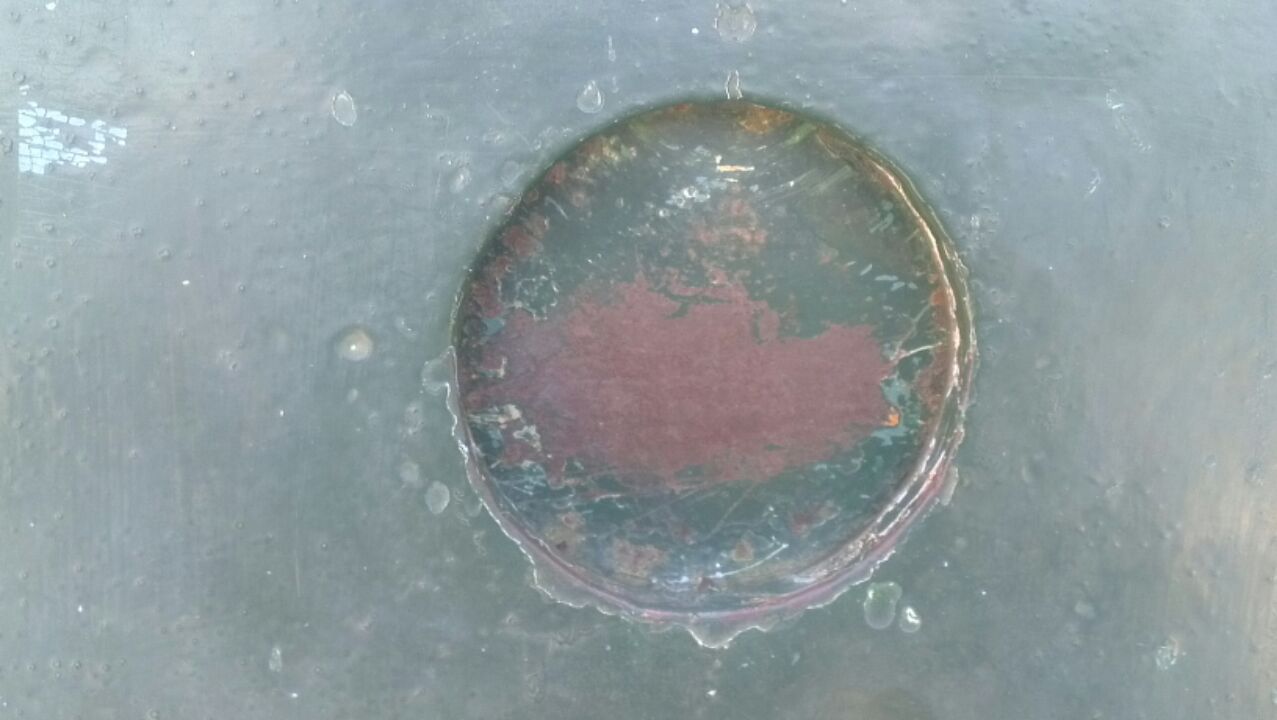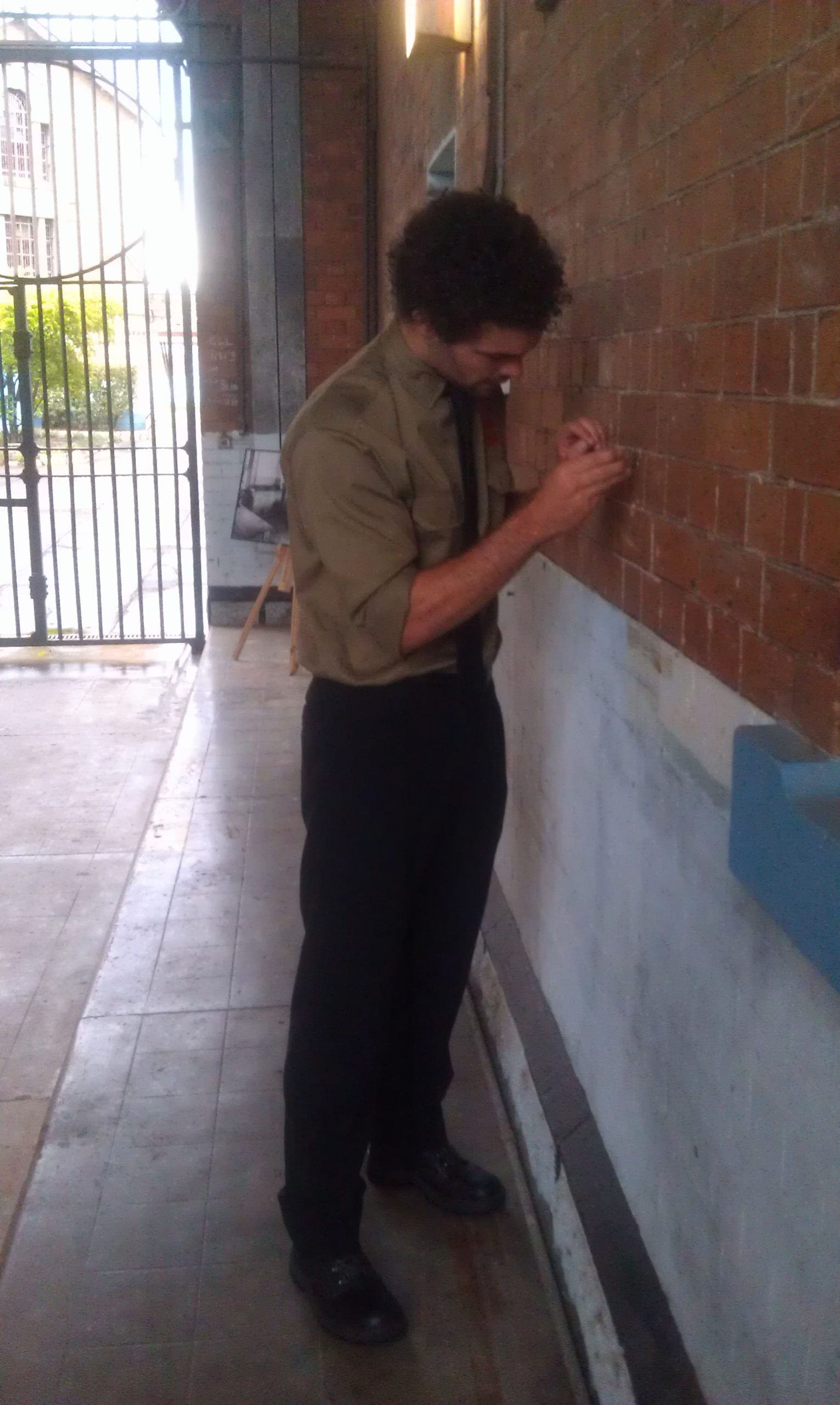THE LAST BUSHRANGER IN QUEENSLAND : James Kenniff (1940)
Charters Towers, a beautiful outback town South West of Townsville was once a thriving hub due to the large deposits of gold (the second largest city outside of Brisbane). As the gold dried up, mining became uneconomic, Charters Towers population slowly declined, but the stunning old buildings and ghosts remained.
On the outskirts of Charters Towers sits what the locals call “the old cemetery”, the Lynd Highway Cemetery was established in 1895. This bleak, barren and dead flat cemetery is bordered by a well maintained cast iron perimeter fence and charming front gate. It is the resting place for a number of interesting local characters including Jupiter Mossman who, as the local lore has it, was one of the party that discovered gold in Charters Towers; Doctor Leonard Redmond who discovered Australian Dengue Fever; Frederick Pfeiffer, owner of the rich Day Dawn PC Mine and James Kenniff who was the last bushranger in Queensland.
James and his older brother Patrick were expert horsemen who made a living by horse stealing – a very serious crime.
They were wanted in connection to the theft of a horse. A police constable, Aboriginal tracker and station master pursued the brothers for several days through hard, mountainous country in Western Queensland. Surprising Patrick and his brother James they managed to overpower and arrest them both. As the tracker was sent to get handcuffs from the constable’s packhorse, gunshots rang out and the tracker ran for his life.
A later search found the constable’s horse wandering through the scrub and the burnt remains of the constable and station master. The brothers were tracked down again and following a shootout, both were captured and tried for murder.
Throughout the trial Patrick maintained his innocence and was denied the right to appeal to the Privy Council in London, by the judge Samuel Griffith. Though there was public shock and outcry, the Queensland Government seemed to be determined to see him hang.
Patrick was sent to the Gallows of Boggo Road Gaol, protesting his innocence to the very last. His final chilling words were saved for one man, the Chief Justice, now Sir Samuel Griffith: “I am as innocent as the judge who sentenced me.”
James’s life was spared, but he was sentenced to life imprisonment with hard labour. Being released in 1914, he refused visitors and lived out his life alone. Some say he was the one who pulled the trigger. He took the secret to his grave in Charters Towers.
Hear about this amazing story on Australia’s longest running true crime show “True Crimes” – presented by Jack Sim on 4BC Nights with Walter Williams. Thursday evenings 9.35pm on Radio 4BC.
Visit the grave of Patrick Kenniff on a South Brisbane Cemetery Ghost Tour
Fish in Prison: Riots from a prisoner’s perspective (1980s)
In the 1980s Boggo Road Gaol was constantly in the headlines. It became a place of riots, hunger strikes and rooftop protests. Many of the prisoners were prepared to starve themselves and even die to tell the world that Boggo Road Gaol needed to go. Within No.2 Division, cells had no toilets and running water, food was inadequate, and prisoners were often treated harshly. Compared to the rest of Australia, it was like going back a century.
Over the years there were many riots and protests leading up to the closure of Boggo Road Gaol. In 1983 rioters took over and destroyed the Industrial Division, damaging cells to the point they were uninhabitable for six months. They rioted in D Wing, burning their sanitation tubs, urinating and dropping burning debris on the fire brigade and officers as they attempted to subdue the inmates.
Finally the authorities started to take notice and in 1986, construction of three new prisons was granted and work began to build the Wacol HM Brisbane Industrial Prison, HM Prison Chewko and Borallon Prison. In 1988 the Cabinet commissioned Mr Jim Kennedy to review the corrective services in Queensland bringing about the closure of Boggo Road Gaol, with No.2 Division being closed in 1989.
Glen “Fish”, a former prisoner at Boggo Road Gaol during the 1980s, witnessed firsthand the chaos within the red brick walls: being crammed in exercise yards with 30 other men, the brutal bashings and hunger strikes. On 4BC TRUE CRIMES Jack Sim will be discussing this tumultuous time in the Prisons history and the closure of Boggo Road Gaol.
Listen to this fascinating story on Australia’s longest running true crime show TRUE CRIMES – presented by Jack Sim on 4BC Nights with Walter Williams. Thursday evenings 9.35pm on Radio 4BC.
“I AM SURE I FIRED THREE” THE HOLLAND PARK TAXI MURDER (1939)
This year marks 75 years since Derwent Evans Arkinstall murdered taxi driver Howard Thomas Chambers at Holland Park on Brisbane’s Southside. In June 1939, Brisbane was shocked when it was learnt that the killer was only 18 years of age. An electrician’s apprentice Arkinstall seemed a most unlikely killer. Indeed when interviewed by police soon after his arrest in Bangalow New South Wales where he had fled after committing the crime, he seemingly did not realise the gravity of what he had done: “It was not an accident, and I did not do it deliberately, yet I do not know how I did it. I just took the revolver out of my pocket and fired it.”
It was truly a terrible crime. Tom Chambers was a veteran cabbie, 74 years of age. His body was found at Slack’s Creek. He had been shot twice in the back of the head and once in the forehead – to make sure he was dead.
When he appeared in Brisbane Police Court Arkinstall was asked whether he admitted he had fired the shots that had killed Chambers. Cold-bloodedly the youth responded “They say there were only two shots, but I am sure I fired three”. Arkinstall was found guilty of murder in the Supreme Court soon after.
He would spend 43 years living behind the walls of Boggo Road Gaol becoming Australia’s longest serving prisoner at that time. In “Boggo” he was regarded as a dangerous trouble maker. In 1946 notorious escapologist Arthur Halliday, Arkinstall and Victor Travis staged one of the most daring prison breaks in Australian history. For this he was never trusted again.
His release 31 years ago was controversial. He had only one word for reporters at the time when asked what it was like to be leaving prison – “wonderful”.
The 62 years old had been released to die as a free man. In this case justice could truly have been said to have been served – prison had claimed the best part of Arkinstall’s life.
Listen to True Crime – every Thursday at 9.30pm on Radio 4BC for this and more crime stories.
THE CHERMSIDE TOMAHAWK MURDER (1959)
In 1983, Brisbane residents were shocked to read of a campaign to release a forgotten murderer from behind the bars of Boggo Road Jail. Wife killer, Jack Foy 66, was at the time Queensland’s longest serving prisoner. His savage crime, his first and only offense shocked the people of Chermside 24 years earlier.
Out on the “back track” of Number 2 Division at Boggo Road Gaol, a lonely lifer weeded and swept. This elderly figure caused no trouble and longed to hear the sound of birds once again. When asked by a new prison officer what he was in for, Jack Foy would reply ‘I got life because his wife nagged me’.
Though now a frail crippled old man, on the 18th of June 1959 Jack Foy was a fit, hardworking labourer, well-liked by his neighbours and friends, but also an alcoholic.
The 42 year-old council worker and local handy-man was addicted to drink. He and his wife Lola 41, lived in Kingsmill Street Chermside. Jack was an epileptic and should not have been drinking; a fact Lola reminded him of daily. It seems that her nagging resulted in Jack picking up a tomahawk and striking her in the head. The Foy’s neighbour Mrs Jarvis was horrified when Jack walked over to the fence and handed over his little daughter saying ‘I’ve killed Lola, could you look after the kids and call the Police?’
Foy seemed like an unlikely killer in late 1983 after 25 years in Prison, Jack Foy was released to die as a free man.
When does “life” imprisonment mean for life?
Listen to True Crime – every Thursday at 9.30pm on Radio 4BC for this and more crime stories.
THE HUSBAND WHO DROWNED HIS WIFE (1961)
The public interest in and media coverage of the trial of Gerard Baden Clay mirrors that of half a century ago when Dutchman Hank Plomp claimed his pregnant wife vanished at night after a swim. When 30 year-old Brisbane City Council bus driver Hendrikus Plomp staggered out of the surf at Southport 53 years ago to report his wife Fay missing, something didn’t add up. The saga of Plomp would carry on for years in Queensland’s courts and newspapers, and inside the walls of Boggo Road Gaol where Plomp was to serve his time. Like the case of Baden Clay, no one saw what actually happened.
Hank Plomp and his wife Fay, lived in Petrel Street Inala, Brisbane. They had two young children, Faye was pregnant with a third, at the time of the tragedy.
On February 24, 1961 Plomp took his wife to the Gold Coast on a day trip. At 6.30pm they drove to Southport. Fay, a good swimmer wanted to have one last dip at Main Beach, they entered the water leaving their son in their car.
What happened next depended on who’s version you believe. Police maintained that Plomp told them that waves knocked he and his wife over twice and that Fay was dragged under. Plomp grabbed the shoulder strap of her swim suit, but it broke and she disappeared underwater. Plomp then raised the alarm at a nearby shop ; Police were called. This version of events relayed by Plomp was later denied by him. Detectives claimed that when her body was found later that night her shoulder straps were intact.
Fay’s family and friends suspicions of murder were confirmed 45 minutes before her funeral when Hank claimed his wife’s insurance. Plomp it seemed had been living a sordid lie. After his wife’s death, he was put on trial for rape of another woman and it was revealed he had a mistress, who he had promised to marry. It seemed he had taken the advice of a work colleague ‘If you want to get rid of your wife, the easiest way is to take her swimming and hold her under. Then feel sorry and start to cry.’
The council bus driver had thought his plan to be cunningly simple. Ultimately a jury convicted him of murder after just 90 minutes. After many years Plomp was released from Boggo Road Gaol after a series of appeals against his conviction… He returned to Holland taking his family with him.
The question remains: was the shoulder strap broken or intact?
Listen to True Crimes – every Thursday at 9.30pm on Radio 4BC for this and more crime stories. Next THE CHERMSIDE TOMAHAWK MURDER (1959)
HERITAGE WORK: Padlocks – Acquisitions
It never ceases to amaze us the incredible connections to Boggo Road Gaol that are out there in the community. We recently acquired four original prison padlocks from a member of the public whose father performed maintenance for the State Government at Wacol prison. Three are “Chubb” brand padlocks, commonly used to secure cell doors due to their incredible strength – the clasp was capable of withstanding 38 tonnes of pressure! One Chubb is in exceptional condition with three unused matching keys; the other two are very old and had seen a lot of use. Given their age and providence these would have come from Boggo Road Gaol. Incredibly each still has a matching key albeit worn. Chubb padlocks were used throughout Boggo Road Gaol and other Queensland prisons through the 1950s to 1980s. Expensive pieces of security in their day, they were originally manufactured in London. They are still made today retailing for approx. AU$175. The fourth padlock was a brass “Jackson” brand. These simple but strong locks were usually used on cellblock gates.
Modern collectors have driven the prices of old locks up in recent years but our interest in these was their connection to Queensland’s prison history. These rare items will be used to demonstrate to visitors on our HISTORY OF BOGGO ROAD GAOL Tour how prisoners were locked up. Any willing volunteers?
IMAGES OF THE PAST: THE BRISBANE GAOL
This is the earliest known photograph of the Brisbane Gaol as viewed from Bolgo Road (“Boggo Road”), circa late 19th century, showing the drive and gatehouse. Opened in 1883, the prison would become infamous. Number Two Division, the only remaining section today, had not yet been constructed at the time this photograph was taken.
Source: Farrell, J. former prison officer, Brisbane Prison.
BOGGO ROAD GAOL WHAT IS IT?
This is the first BOGGO ROAD GAOL WHAT IS IT image. We will post WHAT IS IT? on a regular basis on our BLOG and FACEBOOK. We want your guesses. We will let you know WHAT IT IS at the end of the week!
Get guessing…
SECRETS OF BOGGO ROAD – NUMBER TWO DIVISION CIRCA 1930s

HERITAGE WORK
Boggo Road Gaol Tour Guide Toby Martin carefully removes ‘Bluetac’, sticky tape and other rubbish from the walls of the Gatehouse in Number Two Division; left from years of poorly managed events and functions, this laboursome task is one of many being carried out by Boggo Road Gaol staff to reinstate the image of the prison as a heritage site. Our Tour Guides are passionate about the significance of Boggo Road in Queensland’s history – when not taking tours or re-enacting they have been hard at work removing non-original material deposited from years of abuse.
Number Two Division closed in 1989, and during the early 2000s was a popular venue for parties. Inadvertently many hirers did not realise when they put up streamers, balloons and decorations at these events that evidence of their celebrations would remain a decade later.
When Number Two Division was in use as a prison substances such as Bluetac were never used. Unfortunately it can now be found throughout the entire prison – particularly on walls including those in F Wing cellblock taken in on the HISTORY OF BOGGO ROAD GAOL Tour.
Each blob of Bluetac takes around 5-10 minutes to remove. ‘Although people would assume Bluetac would not harm brickwork, left for years to dry out or harden in the sun has made it a challenge. It can be extremely difficult to remove. We cannot use chemicals or solvents as this is a heritage site so it is a gradual process of teasing the substance off the surface using new Bluetac or water.’ According to Jack Sim, ‘slowly and carefully we are gradually removing all trace. It is a shame that this was not policed in the past.’
New signage throughout the Gaol is being fixed in place with easily removable adhesive tape and will routinely be checked and replaced as it ages.


